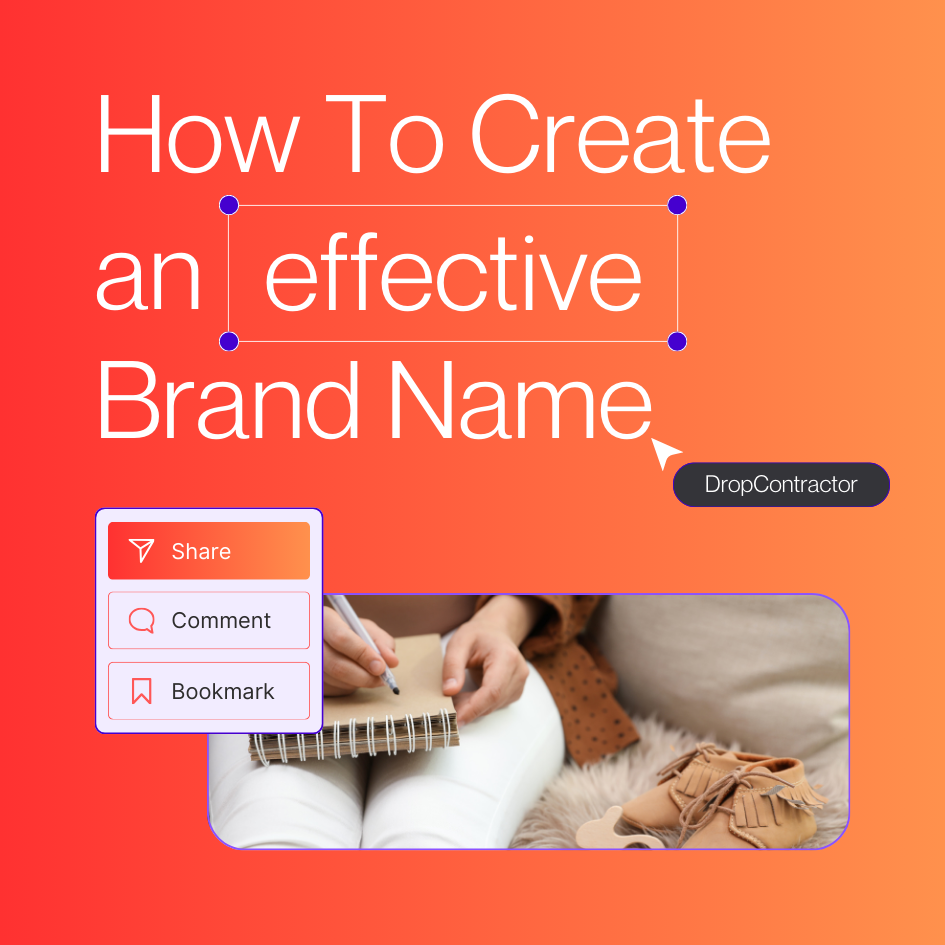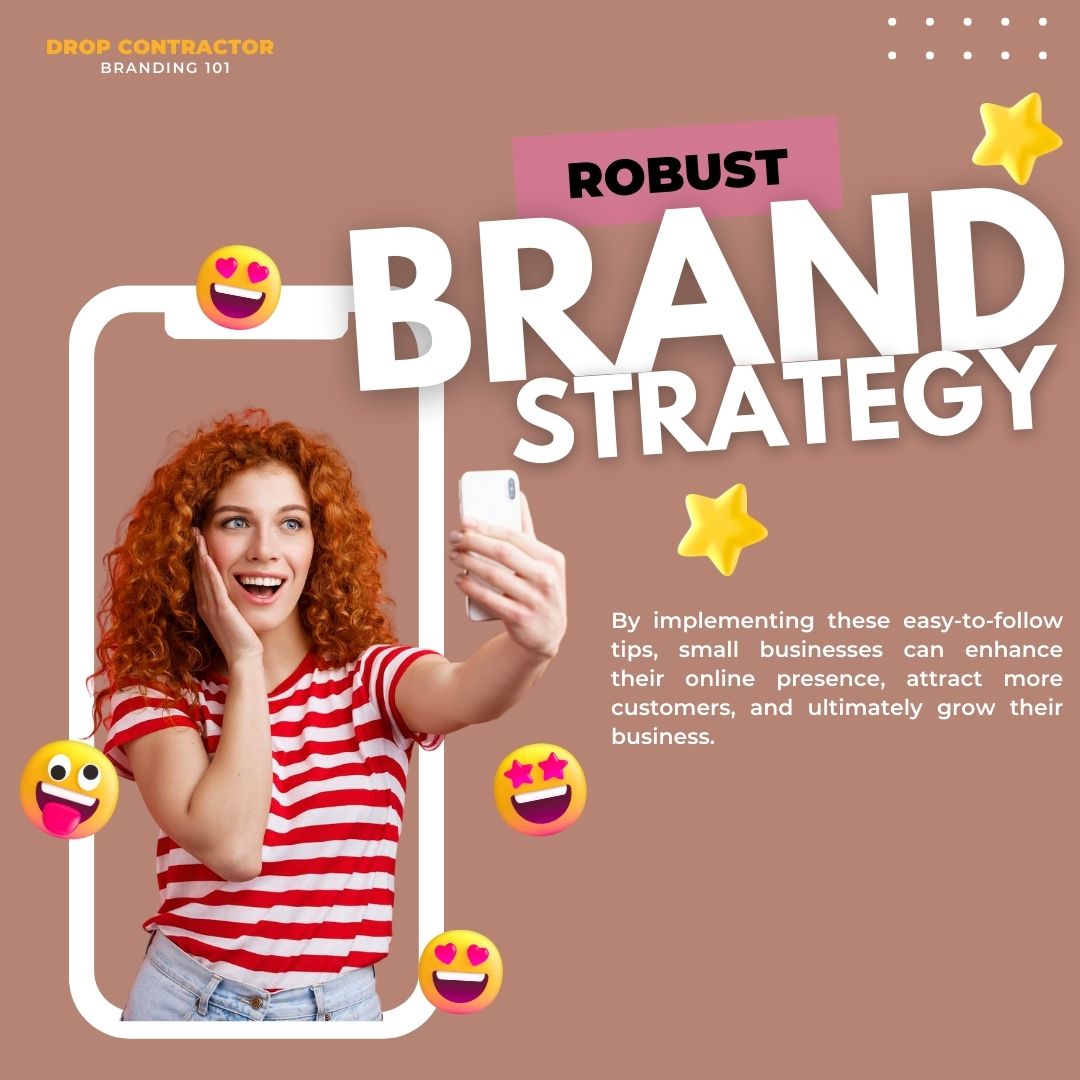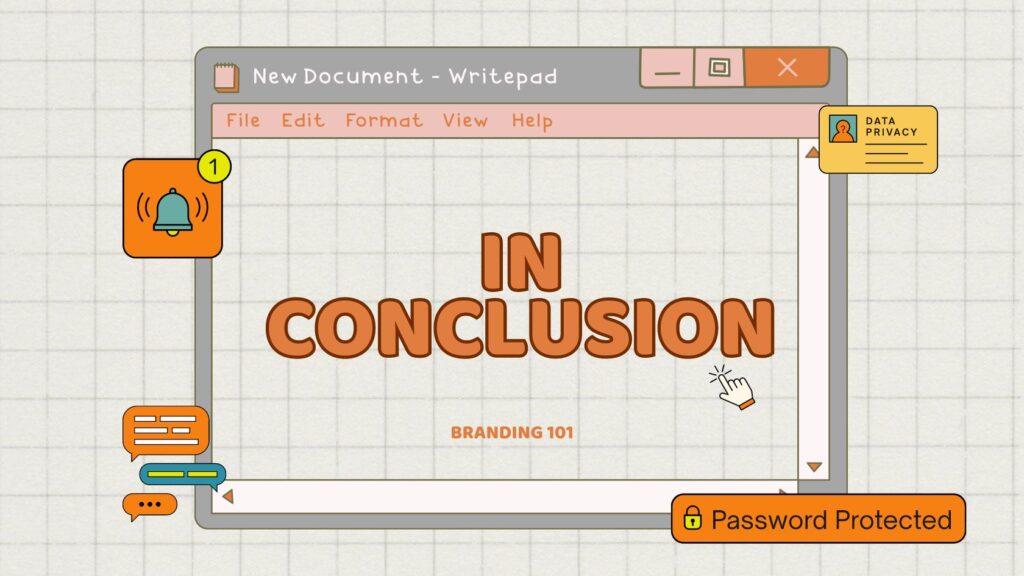

Branding 101: Your Guide to Building a Powerful Brand Identity and Maintaining it
Hello and Welcome to Branding 101 by DropContractor, I’m super excited to guide you through the art of transforming your brand into a powerhouse. Unlike conventional approaches, i’ll skip the mundane definitions and dive straight into practical strategies and insights.
Together, we’ll embark on a journey of refinement and innovation, equipping you with the tools and knowledge to elevate your brand to new heights. Let’s embark on this enriching journey and unleash the full potential of your brand, one step at a time.
Table of Contents:
Steps to take for a perfect branding strategy
1. Define your brand's purpose, vision, and values
Clarify the core essence of your brand by outlining its purpose, vision for the future, and the values it stands for.
Go to Section 1
2. Identify your target audience
Understand who your ideal customers are, their preferences, behaviors, and needs to tailor your message and offerings effectively.
Go to Section 2
3. Develop a unique positioning strategy
Stand out in the crowded market by identifying gaps in the competition and offering a distinct value proposition to your target audience.
Go to Section 3
4. Craft a compelling brand personality
Define the human traits and characteristics that embody your brand, creating a relatable and engaging persona for your audience to connect with.
Go to Section 4
5. Create a cohesive visual identity
Design a consistent look and feel for your brand, including elements such as logos, colors, fonts, and imagery, that reflect its personality and values.
Go to Section 5
6. Nail your brand messaging
Articulate your brand’s story, benefits, and value proposition clearly and persuasively across all communication channels to resonate with your audience.
Go to Section 6
7. Harness the power of storytelling
Create compelling narratives that evoke emotions and build connections with your audience, fostering trust and loyalty towards your brand.
Go to Section 7
8. Choose a memorable brand name and tagline
Select a name and tagline that encapsulate your brand’s essence and promise, making it easy for customers to remember and identify with.
Go to Section 8
9. Design a visually stunning brand identity
Create visually appealing assets that leave a lasting impression on your audience, reinforcing your brand’s identity and values.
Go to Section 9
10. Implement a robust marketing strategy
Develop a comprehensive plan to promote your brand across various channels and platforms, increasing its visibility and reach among your target audience.
Go to Section 10💡 These steps apply universally to all types of branding. Whether you are developing a personal brand, establishing a business brand, or launching a product brand, maintaining consistency, embracing evolution, and engaging your audience are essential for long-term success.
Step 1:
Define Your Brand’s Purpose, Vision, and Values
Your brand isn’t just about logos or products; it’s the heart and soul of your business. It goes beyond surface-level symbols, representing the why behind your actions, where you’re going, and what you stand for. Your brand is like a compass, guiding your journey and reflecting your passions, dreams, and values.
But, How to Define my Brand’s Purpose, Vision and Values?
To define your brand’s purpose, vision, and values, start by asking yourself why your business exists, where you see it heading in the future, and what principles it stands for.
Clarify the core essence of your brand by outlining its purpose – the reason it exists, its vision – where it aims to be in the future, and its values – the principles it upholds. This exercise helps you articulate the driving force behind your brand and provides a clear direction for your business.


Real-Life Example: Let’s explore Garden Glow, our beloved nursery plant business co-owned by my wife (pictured above) and me. We specialize in providing premium, locally sourced and produced plants alongside exquisite imports like Holland’s finest tulips or Japan’s cherry blossoms. Our mission is clear: to champion sustainable gardening practices and enrich our community’s green spaces. Excited to see our brand flourish!
Actionable Steps we took and you can take as well for your brand:
- Reflect Together: Dedicated time with my co-owner (my wife) to ponder deeply & Brainstorm on the driving force behind our nursery plant business.
- Inspiration Discussion: Shared what ignites our passion for sustainable gardening and envisioned how Garden Glow can positively impact the community.
- Craft Your Statement: Created a concise statement that encompasses the purpose, future vision, and values of Garden Glow.
- Guiding Beacon: Letting this statement serve as the guiding light for all branding endeavors, ensuring alignment with our brand’s essence and aspirations.
Key Takeaway from this first step in branding: Reflecting on your brand’s purpose, vision, and values is not just an exercise in theory; it’s a vital step in laying the foundation for your business’s identity. By defining these elements, you not only clarify your direction but also set the tone for all future branding efforts, ensuring consistency and authenticity in your messaging and actions.

Step 2:
Identify Your Target Audience
Understanding who your customers are is super important for making your business work. It’s like knowing exactly who will engage with what you have to offer so you can make more & more of what they like. When you know your audience, you can talk to them in a way that really clicks, and that’s key for making them want to buy from you. Plus, when you get what they like, you can make products they’ll love, which keeps them coming back for more. Building these strong connections with your targeted customers is what helps your business grow and thrive in the long run.
How to identify your target Audience?

1. Cast a Wide Net
Begin by considering basic demographics such as age, location, and income. This broad view lays the foundation for understanding your audience.

2. Explore Psychographics
Delve deeper into your audience’s interests, values, and lifestyle choices. This insight provides a more nuanced understanding of their motivations and preferences.

4. Conduct Market Research
Use surveys, focus groups, and interviews if you can to gather direct feedback from your target audience. This hands-on approach helps you gain valuable insights into their needs and pain points.

4. Analyze Social Media Data
Leverage analytics tools to track engagement, demographics, and behaviors on social media platforms. This data offers real-time insights into your audience’s online activities and preferences.
Real Life Example:
Identifying our target audience for Garden Glow was like finding the perfect soil for our plants – essential for growth! First, my wife and I brainstormed who might be interested in our plants. Then, we looked at our local community & trade shows to see who was already buying similar products.
We used surveys and social media to ask people about their gardening habits and preferences. By doing this, we discovered that our ideal customers were environmentally conscious individuals who loved gardening but were also busy and looking for easy-care plants.
This helped us tailor our messaging and offerings to meet their needs, like offering low-maintenance plants and eco-friendly gardening tips.

Understanding Customer Profiles:
- Brainstormed Together: My wife and I sat down and brainstormed potential customer profiles based on our knowledge of gardening enthusiasts and eco-conscious individuals.
- Local Community Observation: We observed the customers frequenting local nurseries and garden centers to understand their demographics and preferences.
- Surveyed Potential Customers: We conducted surveys both online and in-person (mostly our friends and acquaintances) to gather insights into people’s gardening habits, preferences, and pain points.
Analyzing Data and Traits:
- Analyzed Social Media Engagement: I dove into social media groupes (mostly Facebook, reddit and twitter) to see who was engaging with gardening-related content and what they were saying.
- Identified Common Traits: Through my research, i identified common traits among our desired target audience, such as a love for gardening, eco-consciousness, and a desire for easy-care / hassle free plants.
Refining Audience Profile:
- Refined Our initial Audience Profile: Based on what i found, we refined our target audience profile to focus on environmentally conscious individuals with a passion for gardening and limited time for maintenance.
- Separate the audience into two categories: eco-conscious individuals and groups seeking sustainable gardening options, and businesses and locals aiming to beautify their neighborhoods.
Step 3:
Develop a unique positioning strategy
Developing a unique positioning strategy is akin to discovering your own vibrant corner in a bustling playground. To truly stand out, you must keenly observe the playground dynamics—what others excel at and where they falter. Then, pinpoint what sets your business apart—perhaps it’s the remarkable diversity of your offerings or the bespoke services you provide (Even if it just a drop shipped product from china).
With this insight, craft a magnetic message that amplifies your distinctiveness and speaks directly to your audience’s desires. This strategic move establishes your business as the coveted hotspot, drawing in those in search of something truly extraordinary.


Market Analysis & Competitor Research: Study your competitors to identify gaps in the market and areas where they lack.

Identify Unique Selling Points: Determine what makes your business special and how you can leverage it to stand out.

Craft Compelling Message: Develop a clear and captivating message that highlights your unique qualities and resonates with your target audience.

Step 4:
Craft a compelling brand personality ( & brand persona)
Crafting a compelling brand personality is akin to giving your business a unique identity—a distinct set of human traits and characteristics that breathe life into your brand. It’s about infusing your business with personality traits that resonate with your audience, creating a deep and meaningful connection.
Imagine your brand as a person. What qualities would they possess? Are they bold and adventurous, or perhaps nurturing and empathetic? By defining these traits, you’re not only giving your brand a distinct identity but also making it more relatable and engaging to your audience.
Think about how you want your audience to perceive your brand. Do you want them to see it as trustworthy and reliable, or maybe innovative and cutting-edge? Whatever personality you choose, make sure it aligns with your brand values and resonates with your target audience.
Once you’ve defined your brand personality, infuse it into every aspect of your business—from your marketing materials to your customer interactions. By consistently embodying these traits, you’ll create a brand persona that not only stands out in the market but also forges a deep and lasting connection with your audience.


Example:
Let’s delve into the vibrant world of Garden Glow, where each plant has its own story to tell and personality to share. Inspired by the lush greenery of our garden and the colorful blooms that dance in the sunlight, Garden Glow embodies the spirit of a nurturing friend who guides you through the joys of gardening. With warmth and authenticity, our brand exudes a sense of tranquility and excitement, inviting customers to embark on a botanical journey filled with wonder and discovery.

Character Discovery: We immersed ourselves in the essence of our garden, observing the unique traits and personalities of each plant. From the resilient succulents to the delicate roses, we identified the diverse characteristics that define our brand.

Story Crafting: Drawing inspiration from our garden’s beauty, we crafted compelling narratives for each plant, weaving together tales of growth, resilience, and transformation. These stories became the heart and soul of our brand, infusing Garden Glow with depth and meaning.

Visual Expression: To bring our brand persona to life, we curated a visual identity that reflects the personality of our garden. From earthy tones to vibrant hues, every color and texture was carefully chosen to evoke a sense of warmth and enchantment.

Communication Style: Embracing the friendly demeanor of our brand persona, we adopted a conversational tone in our communication efforts. Whether through social media posts or product descriptions, we strive to engage our audience in authentic and meaningful conversations.

Customer Connection: By embodying the nurturing qualities of our brand persona, we fostered deeper connections with our customers. Through personalized recommendations and attentive service, we ensure that every interaction with Garden Glow is an enriching experience.

Consistent Presence: To maintain the integrity of our brand persona, we remain consistent across all touchpoints. From our website to our packaging, every element reflects the personality and values of Garden Glow, creating a cohesive and immersive brand experience.
Step 5:
Create a cohesive visual identity
Crafting a cohesive visual identity is like painting a masterpiece that tells your brand’s story at a glance. It’s about harmonizing colors, fonts, and imagery to create a consistent look and feel across all touchpoints.
Start by defining your brand’s personality and values—this will guide your design choices. Then, choose a memorable logo that encapsulates your brand essence. Select a color palette that evokes the right emotions and fonts that complement your brand’s tone. Finally, curate imagery that resonates with your audience and reflects your brand’s identity. This unified visual language will help your brand stand out and leave a lasting impression.


Why Visual Identity Matters: Visuals help people remember your brand and trust it more.

How to Create Consistency: Keep the same colors, logos, and styles everywhere your brand appears.

Tailoring Visuals to Your Audience: Use images and designs that your audience likes and relates to.

Using Visuals to Tell Your Story: Pictures and colors can show what your brand is about.

Guidelines for Visual Elements: Make rules for how your brand looks so it always stays the same.

Adapting to Different Channels: Change your visuals a bit to fit on websites, social media, or ads.

Measuring Success: Check if people recognize your brand and like it by looking at numbers and asking them.

Evolution and Iteration: Sometimes you need to change your visuals to stay modern and interesting.
Here Are Some Tips to find the best Colors for your Brand
Tip 1: Know Your Brand, Know Your Colors!
Imagine your brand as a person. Fun and playful? Think bright yellows and playful oranges! Sophisticated? Deep blues and rich purples with a touch of silver will add a touch of class. Don’t forget your target audience! Are you aiming for happy kids? Vibrant colors might work best. Targeting adults seeking security? Calming blues and greens might resonate more.
Tip 2: The Color Wheel: Your Secret Weapon!
The color wheel is your key to creating dynamic color schemes. Complementary colors, like red and green or blue and orange, sit opposite each other and create a high-energy contrast. Use them sparingly for accents to avoid overwhelming viewers. Analogous colors, like blue, blue-green, and green, create a harmonious and calming vibe, perfect for a consistent brand identity.
Tip 3: Inspiration, Not Imitation!
Feeling stuck? Look to successful brands in your industry for color palette inspiration. See what colors they use and how they create a cohesive look. Many online color palette generators can also offer pre-built options or suggest colors based on your input. But remember, the goal is to find a unique color combination for your brand, so use these resources as a springboard for your creativity!

Step 6:
Nail your brand messaging
Nailing your brand messaging is like painting a vivid picture that captivates your audience’s imagination. It’s about articulating your brand’s story, benefits, and value proposition in a way that resonates deeply with your audience. The goal is to create a compelling narrative that not only grabs attention but also builds trust and loyalty.
To achieve this, you need to ensure consistency across all communication channels, from your website and social media to your packaging and customer service interactions. By delivering a clear and persuasive message that speaks directly to the needs and desires of your audience, you establish a strong emotional connection that sets you apart from the competition.
Why is it important? Brand messaging is the heartbeat of your business—it’s how you communicate who you are, what you stand for, and why you matter. In today’s crowded marketplace, where consumers are bombarded with endless choices, having a strong and cohesive brand message is essential for cutting through the noise and making a lasting impression. It not only helps you attract new customers but also fosters loyalty and advocacy among your existing ones. Ultimately, nailing your brand messaging is the key to building a brand that stands the test of time.
Example:
At Garden Glow, we understand the importance of crafting brand messaging that speaks directly to our audience’s hearts. As we embarked on this journey, we realized that our customers aren’t just looking for plants—they’re seeking a connection to nature, a sense of community, and a commitment to sustainability.
Actionable Steps we took to nail our Brand Messaging:

Know Your Audience
We delved deep into understanding our audience’s values, preferences, and lifestyle. Through surveys, social media engagement, and face-to-face interactions, we gained valuable insights into what matters most to them.

Craft Authentic Storytelling
Armed with this knowledge, we crafted authentic storytelling that resonates with our audience’s aspirations and beliefs. We shared stories about the origins of our plants, the artisans behind our products, and the impact of sustainable gardening on the environment.

Personalize Communication:
We personalized our communication channels to reflect the unique cultural nuances of our audience. From the language we use to the imagery we showcase, every touchpoint is tailored to evoke a sense of belonging and connection.
Extended View On Step 6: Mastering Storytelling & Brand Messaging
People don’t just buy products, they connect with stories. This section is all about crafting a captivating brand story that goes beyond features and benefits. Think about it – would you rather hear a boring list of ingredients, or a story about a delicious family recipe passed down for generations? Stories are powerful!

Imagine this: You’re choosing between two camping backpacks. One lists features like “waterproof” and “multiple compartments.” The other tells a story about a family adventuring through stunning landscapes, their trusty backpack keeping their gear safe and organized. Which one are you more likely to remember?
- Show, Don’t Tell: Features are boring. Benefits are a bit better. But a story shows your audience how your product or service can improve their lives.
Tip: Instead of saying “Our shoes are comfortable,” tell a story about a busy professional who feels confident and ready to take on the day thanks to your comfortable shoes.
- Unique Selling Proposition (USP) Spotlight: Your story is your chance to showcase what makes your brand special. It’s your USP, the one thing that sets you apart from the competition.
Tip: What makes your product or service unique? Does it use sustainable materials? Offer exceptional customer service? Highlight your USP in your story and show why it matters.
Step 7:
Harnessing Storytelling for Emotional Connection
In branding, storytelling is like magic. It’s the power to captivate, inspire, and connect with your audience on a deep emotional level. As a small business, storytelling can be your secret weapon to stand out in a crowded market.
Think about how you want your audience to perceive your brand. Do you want them to see it as trustworthy and reliable, or maybe innovative and cutting-edge? Whatever personality you choose, make sure it aligns with your brand values and resonates with your target audience.

Some Actionable Steps to become great in storytelling

Understand Your Audience
Get to know who your customers are, what they care about, and what challenges they face. Tailor your stories to resonate with their experiences and emotions.

Tell Genuine Stories
Share real-life experiences, challenges, and successes that reflect your brand’s values and personality. Authentic stories are more relatable and create stronger emotional connections.

Use Clear and Simple Language
Keep your storytelling straightforward and easy to understand. Use words and phrases that your audience can relate to, avoid jargon or complicated language.

Show, Don’t Just Tell
Use vivid imagery and descriptive language to paint a picture in your audience’s minds. Engage their senses and emotions by creating scenes and situations they can imagine themselves in.

Create a Story Arc
Structure your stories with a beginning, middle, and end. Build tension, empathy, and resolution to keep your audience engaged and emotionally invested in your story.

Practice Empathy and Active Listening
Listen to your audience’s feedback and stories. Show empathy and understanding, and use their experiences to inform your own storytelling.
Example
Here’s how we worked this part for our own Nursery Plants Business: Garden Glow

To Understand our Audience: We conducted thorough market research to understand the needs and preferences of our target audience. We segmented our audience into two groups: eco-conscious individuals passionate about sustainability and businesses/locals aiming to enhance their neighborhood’s aesthetics.

To Tell Genuine Stories: we shared authentic stories about our journey, highlighting our commitment to sustainability and community beautification. We showcased how our passion for plants led to the creation of Garden Glow, emphasizing our mission to provide high-quality, locally sourced plants while promoting eco-friendly practices.

To Define our Brand Personality: We crafted a brand personality that resonates with our audience, portraying Garden Glow as a friendly, eco-conscious partner in their gardening journey. Through our messaging and visual identity, we conveyed traits like warmth, reliability, and environmental responsibility.

To Craft Compelling Messaging: We focused on the unique value proposition of Garden Glow, emphasizing the benefits of our locally sourced plants and personalized services. We highlighted how choosing Garden Glow not only beautifies spaces but also contributes to a more sustainable future.

For Engaging Content: We developed engaging content across various channels, including social media, blogs, and email newsletters. Our content featured informative gardening tips, behind-the-scenes glimpses of our nursery, and success stories from satisfied customers, fostering a sense of community and trust.

To amplify our brand reach: we leveraged strategic marketing tactics tailored to our audience segments. We partnered with local environmental organizations for collaborative events, sponsored community gardening initiatives, and invested in targeted digital advertising to reach eco-conscious consumers effectively.

Step 8:
Choosing a memorable brand name and tagline For your Business
Choosing a catchy brand name and tagline is akin to selecting a name for a newborn baby—it’s really important! Despite claims of irrelevance from some gurus out there online, it’s something your audience will remember you by. Your brand name should reflect your business’s essence, while your tagline succinctly communicates your promise to customers.
Why Is This Step as Important as the Others?
Memorability: A resonant brand name and tagline stick in the minds of your audience, fostering recall and recognition. This memorability ensures that when customers think of your product or service, they think of you first.
Connection: A well-thought of brand name and tagline create an emotional connection with your audience. When your brand resonates with their values, aspirations, or needs, it fosters a sense of belonging and loyalty.
Differentiation: In a crowded marketplace, a unique brand name and tagline help you stand out from competitors. By encapsulating your unique value proposition or brand promise, they set you apart and attract the right customers.

Brainstorm Keywords:
Start by brainstorming words or phrases related to your business, industry, or the feelings you want your brand to evoke.

Word Play:
Experiment with wordplay, puns, alliteration, or rhymes to make your brand name memorable and fun.

Combine Words:
Mix and match words to create a unique combination that captures the essence of your brand.

Invent New Words:
Create entirely new words or blend existing ones to craft a brand name that is distinctive and trademarkable.

Visualize Concepts:
Think about visual concepts related to your brand and explore names inspired by shapes, colors, or imagery.

Foreign Languages:
Look into words or phrases in other languages that convey the right meaning or evoke the desired emotions.

Test for Availability:
Ensure that the brand name you choose is available as a domain name and across relevant social media platforms.

Seek Feedback:
Once you have a shortlist of potential names, gather feedback from friends, family, or target customers to gauge their reactions and preferences.
Remember to keep your brand name concise, easy to pronounce, and relevant to your brand identity!
Step 9:
Design a visually stunning brand identity
Crafting a visually stunning brand identity involves more than just creating a logo—it’s about weaving together various visual elements like colors, typography, and imagery to convey your brand’s personality and values. These components form the foundation of your brand’s visual language, enabling you to communicate with your audience in a compelling way that resonates with them.

Consistency plays a crucial role in maintaining your brand’s visual identity. Whether it’s your website, social media profiles, or physical products, maintaining consistency across all visual assets is vital. Consistency fosters brand recognition and builds trust with your audience. When your audience encounters consistent visual elements across different touchpoints, they develop a sense of familiarity with your brand, making it easier for them to engage and connect with you.
In a crowded market, a visually appealing brand identity can set you apart from the competition. It leaves a memorable impression on your audience, distinguishing you from others in your industry. By investing in high-quality design and aesthetics, you can capture the attention of potential customers and leave a lasting impact. This differentiation is essential for attracting new customers and retaining existing ones, as it positions your brand as unique and desirable, fostering meaningful connections and driving engagement.
Mastering Visual Branding: Crafting a Compelling Brand Identity

A Necessity of Professional Design
Professional design is crucial for small businesses to build a strong brand image. It adds credibility and trust, making your brand appear reliable and high-quality. Consistent design across your logo, colors, and visuals boosts recognition and memorability.

Elements of a Visual Brand Identity:
Discover the building blocks of your brand’s visual identity, including logos, colors, typography, and imagery. Each element plays a crucial role in conveying your brand’s values, personality, and message, contributing to its overall identity and recognition.

Creating Consistent Visual Assets:
Consistency is key across all platforms and touchpoints to maintain brand integrity. Learn strategies to ensure uniformity in your visual branding, reinforcing brand recognition and coherence. Consistent visuals help establish trust and familiarity with your audience, enhancing brand recall and loyalty.

Leveraging Visual Storytelling:
Visual storytelling captivates audiences and forges emotional connections with your brand. Harness the power of visuals to craft compelling narratives that resonate with your target audience. Through captivating imagery and design, convey your brand’s story and values effectively, leaving a lasting impression on your audience.

Step 10:
Implement a robust marketing strategy to amplify your brand’s reach.
Implementing a robust marketing strategy is like crafting a roadmap to guide your brand’s journey towards success. It involves carefully planning and executing a variety of promotional activities across different channels to ensure maximum visibility and engagement with your target audience. A comprehensive marketing strategy encompasses a range of tactics, including digital marketing, social media campaigns, content creation, email marketing, and more. By leveraging these diverse channels effectively, you can amplify your brand’s reach and influence, driving traffic, generating leads, and ultimately increasing sales and brand awareness
Tips & Ideas
Here are some actionable ideas tailored for small businesses to maintain a unique, consistent marketing strategy that yields results

Boost Local Visibility: Use local keywords and update your Google listing.

Share Helpful Content: Start a blog and offer solutions to customer problems.

Connect on Social Media: Engage with your audience on one or two platforms.

Team Up with Others: Partner with local businesses for mutual promotion.

Offer Special Deals: Attract customers with exclusive discounts or offers.

Listen to Customers: Gather feedback and use it to improve your business.

Go Mobile-Friendly: Ensure your website is easy to use on phones.

Be Consistent & Real: Keep your brand voice and visuals uniform across all channels.
In the dynamic landscape of business, establishing a strong brand is paramount for success. By following the ten essential steps outlined in this guide, small businesses can craft a compelling brand identity that resonates with their audience, drives engagement, and fosters long-term loyalty. From defining your brand’s purpose to implementing a robust marketing strategy, each step plays a vital role in shaping a cohesive and impactful brand presence.
Here Are the Key Takeaways from Each Step of the Process of Branding For Small Businesses
1- Define your brand’s purpose, vision, and values:
- Clarity is key: Clearly define why your business exists, where it’s headed, and what principles guide it.
- Authenticity matters: Ensure that your brand’s purpose aligns with your values to build trust with your audience.
2- Identify your target audience:
- Know your audience: Understand the demographics, interests, and needs of your target customers.
- Tailor your message: Use this understanding to customize your branding and marketing efforts to resonate with your audience.
3- Develop a unique positioning strategy:
- Differentiate yourself: Identify gaps in the market and position your brand uniquely to stand out from competitors.
- Highlight your strengths: Showcase what sets your brand apart and emphasize your unique value proposition.
4- Craft a compelling brand personality:
- Be relatable: Infuse your brand with human traits and characteristics that your audience can connect with.
- Stay consistent: Maintain a consistent brand personality across all touchpoints to build familiarity and trust.
5- Create a cohesive visual identity:
- Visual consistency: Develop a unified visual identity, including logos, colors, and imagery, to create a memorable brand image.
- Reflect your brand: Ensure that your visual elements accurately represent your brand’s personality and values.
6- Nail your branding messaging:
- Keep it clear: Craft concise and compelling messaging that effectively communicates your brand’s story and value proposition.
- Consistency is key: Maintain consistent messaging across all channels to reinforce your brand’s identity and messaging.
7- Harness the power of storytelling:
- Connect emotionally: Use storytelling to create an emotional connection with your audience and evoke empathy.
- Be authentic: Share genuine stories that reflect your brand’s values and resonate with your audience on a personal level.
8- Choose a memorable brand name and tagline:
- Make it memorable: Select a brand name and tagline that are easy to remember and resonate with your audience.
- Capture your essence: Ensure that your brand name and tagline encapsulate your brand’s essence and promise effectively.
9- Design visually stunning brand identity:
- Leave a lasting impression: Develop visually appealing brand assets that make a memorable impact on your audience.
- Reinforce your identity: Use design elements to reinforce your brand’s identity and values consistently across all platforms.
10- Implement a robust marketing strategy:
- Be strategic: Develop a comprehensive marketing plan that aligns with your brand’s goals and target audience.
- Stay adaptable: Continuously monitor and adjust your marketing strategy based on performance metrics and market trends to maximize effectiveness.
Final Words:
I really hope you enjoyed my take on Branding 101 course! It has been a pleasure to share my insights and strategies with you. I believe that with the right branding, any business can stand out and succeed. If you ever need further assistance or personalized guidance, I invite you to explore my 360 Branding Service, specifically designed for small and medium online and local businesses.
This comprehensive service covers every aspect of branding, ensuring that your business not only looks professional but also resonates with your target audience. Whether you need help with logo design, brand messaging, social media strategy, or overall brand development, my 360 Branding Service has you covered.
My ultimate goal is to create a cohesive and compelling brand identity that helps you attract and retain customers. Feel free to reach out if you have any questions or if you’re ready to take your branding to the next level. I’m here to help you achieve your business goals and make your brand shine.
Thank you once again for taking the course, and I look forward to the opportunity to work with you in the future!
Warm regards. AG / DropContractor






